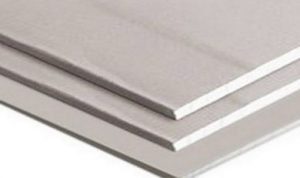Plates intended for the coating of the metal skeleton to which they are screwed. The main material of which are constituted is the plaster, and the paper placed on both faces gives it consistency. The joints between them are treated with tapes and their own masses and, after being sanded, they are painted resulting in a uniform surface. Usually, these plates are known for Plasterboard, Plasterboard or Plasterboard (in Brazil).
The plates do not add resistance to the structure and therefore are disregarded in the engineering calculation. Non-structural partition systems, which include slabs and metal profiles, are often referred to as SCPGL, that is, Plumbing Plates. In Portugal, it is also common to use the term “walls of PLADUR” to designate these types of partitions, due to the popularity that that brand of laminated plaster acquired in the country a few decades ago.

Manufacturing and application
The earliest known use of gypsum dates back about 5,000 years ago in Egypt, where it was used in the manufacture of bricks and the decoration of pyramids.
Around 1755, in France, the chemical nature of gypsum was better understood, with more efficient methods of drying being developed and it was possible to use it in a more practical way. Even today it is often referred to as plaster of Paris, although gypsum exists on all continents, with worldwide extraction around 100 million tonnes per year. The main producers are the United States, Canada, China, France, Iran, Japan, Thailand, Mexico and Spain. In Europe, the market is in the hands of three multinationals, which extract and prepare the plaster for the most varied applications. BPB – British Plaster Board has a market share of approximately 50%, Lafarge some 20% and Knauf – Westdeutsche Gipswerke with around 10%. The remaining 20% corresponds to the production of small enterprises.
The board is manufactured essentially from gypsum, water, and some additives. This wet paste is poured continuously onto paper, receiving a new layer on the upper surface. Thus a kind of paper and plaster sandwich is manufactured which, after drying, is cut into a wide variety of formats. Plasterboards, or plasterboard, are also available in various thicknesses and, depending on the additives they receive, may be intended for different locations in a construction, such as wet environments or where additional fire resistance is required.
The gypsum boards are bolted directly onto the metal structure or glued to masonry walls through their own mass. The joints are treated by the application of reinforced finishing paste with a strip of paper or net.
Subsequently, the hardened slurry is sanded and ready for final painting. If the work is done competently, it will be impossible to distinguish the location of the joints after completion. On the plaster walls may also be glued the most various coating materials, such as the tile.
Many are wondering if they can hang objects on plasterboard walls. The answer is yes. Simply use an expandable bushing suitable for this purpose. Heavier objects, such as a cabinet, can be attached directly to metal profiles, easily detected with a magnet.
Read This Article: Cut Cement Board

Leave a Reply